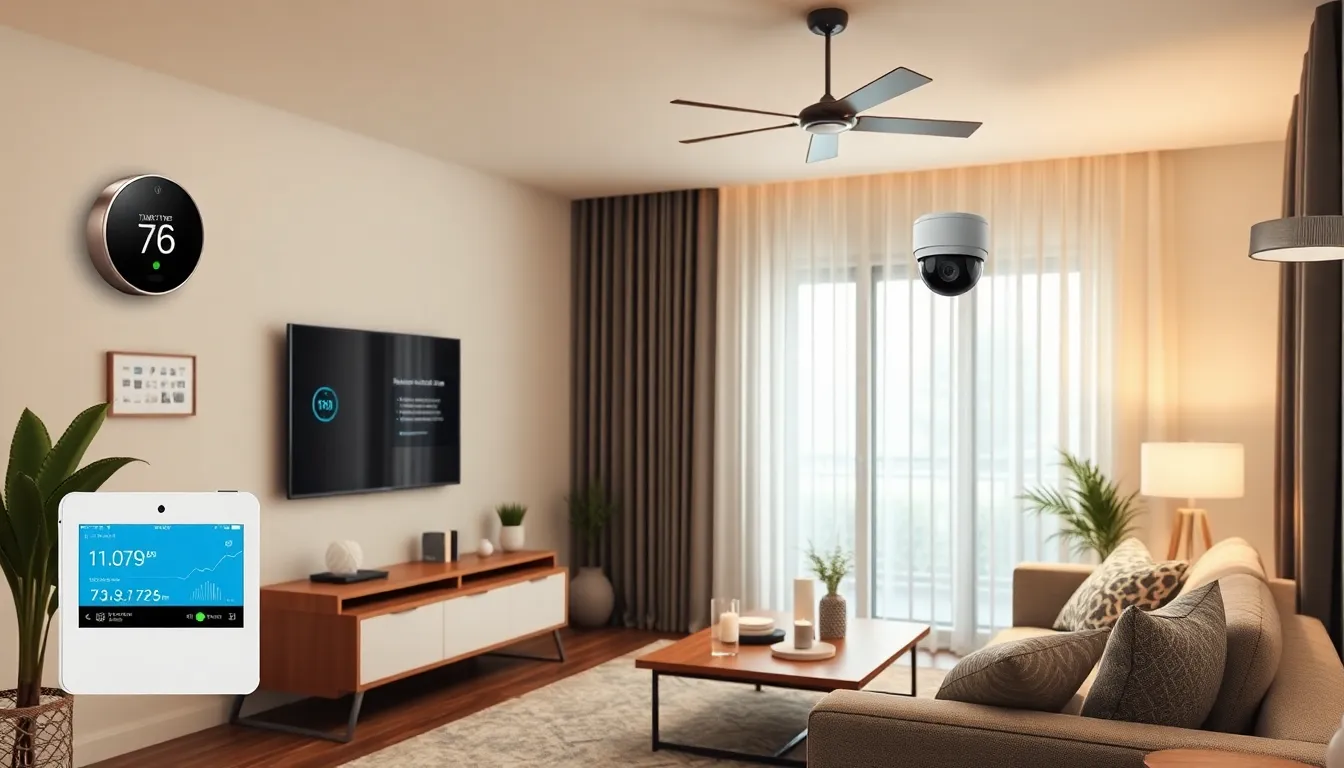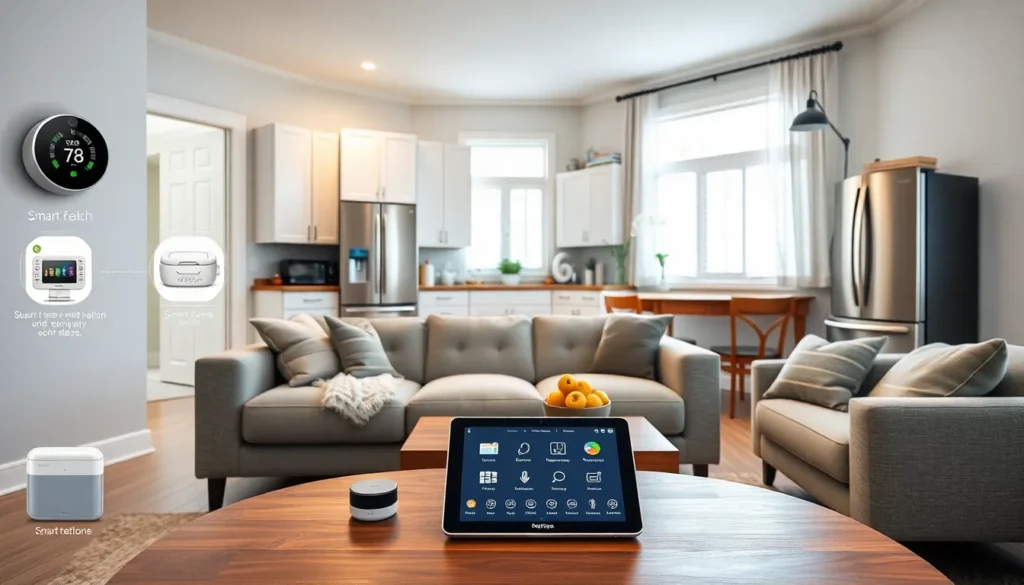Table of Contents
ToggleIn a world where your toaster might just start a conversation with your fridge, the Internet of Things (IoT) is making everyday life a little more connected—and a lot more interesting. Imagine a universe where devices chat, collaborate, and even help you remember where you left your keys. Sounds like a sci-fi movie, right? Well, it’s not. It’s happening right now, and it’s reshaping how people interact with technology.
What Is Internet of Things
The Internet of Things (IoT) refers to a network of interconnected devices that communicate and exchange data. These devices, ranging from household appliances to industrial machines, utilize sensors and software to collect and transmit information over the internet. Smart thermostats demonstrate the IoT concept, allowing users to control temperature settings remotely through mobile applications.
Smart home systems illustrate how IoT enhances everyday life. For example, a smart fridge can notify users when groceries run low, while smart lighting systems adjust based on occupancy. These capabilities lead to improved energy efficiency and convenience.
In numerous industries, IoT transforms operations and increases efficiency. Manufacturing plants employ connected machines to monitor performance metrics in real time. This data-driven approach allows for predictive maintenance, reducing downtimes and operational costs.
Healthcare gains significant benefits from IoT as well. Wearable health devices monitor vital signs and send alerts to healthcare providers if abnormalities occur. Real-time data enables faster response times and ultimately enhances patient care.
Security also evolves with IoT, as connected cameras and motion sensors provide enhanced surveillance in homes and businesses. These devices can alert users of potential threats immediately, increasing safety and peace of mind.
Overall, the Internet of Things significantly impacts modern life by creating smarter environments. Its applications reach far and wide, from personal convenience to large-scale industrial transformations, making technology more adaptive and efficient.
Key Components of IoT

The Internet of Things comprises essential components that facilitate device connectivity and data exchange. Understanding these components clarifies how IoT transforms everyday life.
Devices and Sensors
Devices represent the backbone of IoT systems. These include smart home gadgets such as thermostats, lights, and security cameras. Sensors embedded within these devices collect data, enabling them to monitor and measure various factors like temperature, motion, and humidity. Information gathered by sensors undergoes processing to inform user decisions, optimize energy usage, and enhance overall convenience. For example, fitness trackers analyze biometric data, providing users insights into their health and fitness levels. The combination of diverse devices and sensors contributes significantly to the efficiency of smart environments.
Connectivity
Connectivity forms the foundation for seamless communication among devices. Various protocols facilitate this connectivity, including Wi-Fi, Bluetooth, and cellular networks. These technologies enable devices to transmit data reliably over the internet. Hardware and software handle communication, ensuring data reaches its intended destination promptly. Low-power wide-area networks offer effective solutions for devices requiring minimal energy consumption. For instance, smart agricultural sensors utilize connectivity to transmit soil moisture data to farmers, enabling informed irrigation decisions. Reliable connectivity ensures that IoT devices communicate efficiently, enhancing functionality and user experience.
Applications of IoT
IoT technology finds applications across various sectors, enhancing efficiency and user experiences.
Smart Homes
Smart homes utilize IoT technologies to create a more convenient living environment. Devices like smart speakers control lights and thermostats through voice commands. Other examples include smart security systems that alert homeowners to unusual activities, ensuring safety. Automated home appliances can adjust settings based on user preferences, contributing to energy savings. Furthermore, smart fridges can track inventory and automatically order groceries, simplifying meal preparation. This interconnectedness not only increases comfort but also significantly improves energy management.
Industrial IoT
In the industrial sector, IoT enhances operational efficiency and safety. Smart sensors monitor machinery performance in real time, allowing for immediate responses to potential issues. Connected devices streamline inventory management, enabling accurate tracking of materials and reducing waste. Additionally, predictive maintenance practices help minimize downtime and extend equipment lifespans. Industrial IoT applications also include supply chain optimization, where interconnected systems improve delivery accuracy and speed. Overall, these advancements lead to cost reductions and increased productivity in manufacturing processes.
Healthcare Innovations
IoT plays a critical role in transforming healthcare delivery and patient monitoring. Wearable devices track vital signs like heart rate and glucose levels, providing continuous health data to medical professionals. Remote monitoring systems enable doctors to oversee patients without requiring in-person visits. Examples also include smart medical devices that alert healthcare providers to emergencies, ensuring timely interventions. Moreover, IoT systems assist in managing chronic conditions by sending reminders for medication adherence. This integration of technology ultimately enhances patient outcomes and improves overall healthcare efficiency.
Benefits of IoT
The Internet of Things (IoT) boasts significant benefits across various sectors, enhancing everyday experiences and operations.
Improved Efficiency
IoT optimizes processes through real-time monitoring and automation. Connected devices track performance and operational metrics continuously, enabling quick responses to issues as they arise. For example, manufacturing machines can automatically adjust their functions based on data, reducing downtime and increasing productivity. Companies leveraging IoT enjoy lower operational costs, thanks to predictive maintenance that minimizes unexpected failures. In smart homes, IoT devices manage energy usage intelligently, thereby cutting utility bills. With interconnected systems communicating instantly, efficiency across industries skyrockets.
Enhanced Data Collection
Data collection becomes seamless through IoT devices equipped with sensors. These sensors gather information on various parameters, from temperature readings to user behavior patterns. In healthcare settings, wearable devices monitor vital signs constantly, allowing healthcare professionals access to real-time health data. Smart agriculture technologies collect data on soil moisture, helping farmers make informed decisions, enhancing crop yield. Daily routines benefit as smart homes collect usage data, which fine-tunes device settings for optimal performance. Overall, reliable data collection transforms decision-making processes across industries effectively.
Challenges and Risks
The Internet of Things (IoT) brings several challenges and risks that require careful consideration.
Security Concerns
Security is a predominant issue for IoT devices. Many of these devices, from smart cameras to health trackers, can become entry points for cyberattacks. Poorly secured devices often lack effective measures against unauthorized access, making them vulnerable targets. In 2020, reports indicated that approximately 80% of IoT devices experienced security breaches. Remote access features increase risk levels, as they can provide hackers with pathways to sensitive networks. Regular software updates and strong encryption methods significantly enhance device security, mitigating potential threats.
Privacy Issues
Privacy concerns represent another major challenge associated with IoT. Devices continuously collect user data, raising questions about data ownership and consent. Many individuals may not realize what information their devices gather. For instance, smart speakers can record conversations, leading to unauthorized data usage. According to a study, 70% of consumers express concerns over how their personal information is handled by IoT providers. Organizations must implement clear privacy policies and robust data protection measures to address these issues effectively.
The Internet of Things is undeniably reshaping how people interact with technology in their daily lives. By connecting devices and enabling them to communicate seamlessly, IoT enhances convenience and efficiency across various sectors. From smart homes to industrial applications, the potential for improved operations and user experiences is immense.
However, as the technology evolves, so do the challenges. Security and privacy concerns remain critical issues that need addressing to ensure safe and reliable use of IoT devices. As advancements continue, focusing on robust security measures and user data protection will be essential in harnessing the full potential of the Internet of Things. The future promises a smarter and more connected world, but it’s vital to navigate the accompanying risks responsibly.







